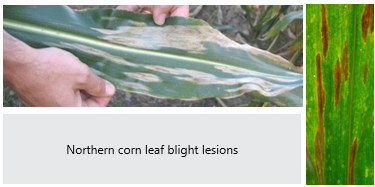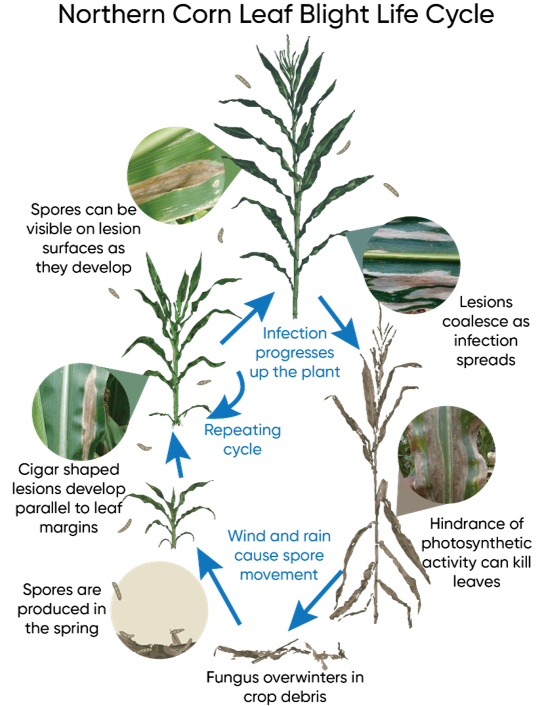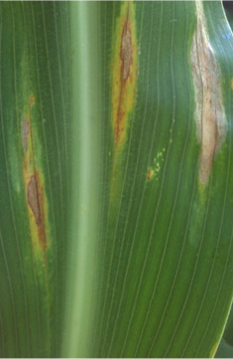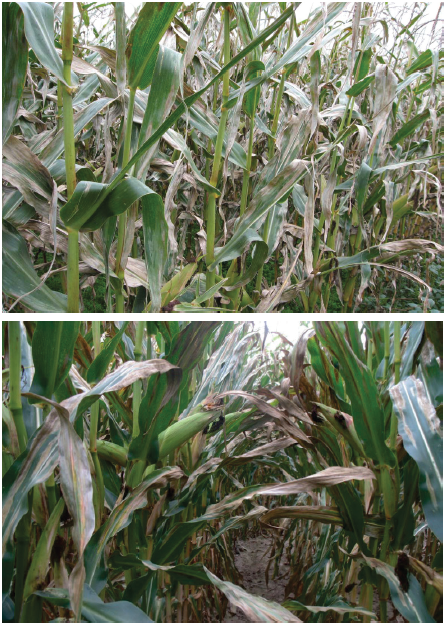Pathogen Facts
- Northern corn leaf blight (NCLB) is a foliar disease caused by the fungus Exserohilum turcicum.
- Disease development is favored by moderate temperatures (64-81 °F, 18-27 °C) and extended periods of leaf wetness (6-18 hours).
- Heavy dew, overcast days, or humid field margins near tree lines can create an environment conducive for disease.
- Exserohilum turcicum overwinters in corn residue, allowing inoculum to build up from year to year.
- Cropping systems with reduced or no-till and/or continuous corn are at higher risk of northern corn leaf blight outbreaks.
Identification
- Infections generally begin on lower leaves and progress up the plant, but infections may begin in the upper plant canopy when spore loads are high.
- Spores progress up the plant by wind or rain splash and may be carried long distances by the wind.
- With optimum conditions, lesions can form in 7 to 12 days after infection.
- Lesions are unrestricted by leaf veins, beginning as elliptical and becoming long, narrow, and “cigar shaped”.
- Coloration of lesions starts as tan or gray-green, and takes on a darker shade as Exserohilum turcicum sporulates.
- Spore coloration ranges from olive green to black, and can be visible with a hand lens. Lesions are often described as appearing “dirty”.
- Lesions can coalesce to form large areas of necrotic leaf tissue, making leaves appear gray/burned.
- New lesions can produce spores in as little as one week, allowing northern corn leaf blight to spread much faster than many other corn leaf diseases.


Figure 1. Life cycle of northern corn leaf blight Exserohilum turcicum in corn. Spores and lesions are enlarged to show detail.
Crop Damage
- Lesions on corn leaves hinder photosynthetic activity, reducing the amount of carbohydrates allocated towards grainfill.
- If lesions progress to the ear leaf or higher two weeks before or after tasseling and pollination, yield loss can occur.
- Yield losses are most severe when northern corn leaf blight infects corn plants early and progresses to the upper plant leaves by pollination or early ear fill.
- Yield losses up to 30% have been reported.
- Because a decrease in functioning leaf area limits photo-synthates dedicated towards grainfill, the plant may mobilize more carbohydrates from the stalk to fill kernels, which can make plants more susceptible to stalk rots and lodging.
Management Considerations
Cultural Practices
- Exserohilum turcicum overwinters in corn debris, so production practices such as tillage and crop rotation, that reduce the amount of corn residue on the surface, will decrease the amount of primary inoculum.
- However, reducing corn residue does not protect against spore showers carried into a field on wind currents.
Hybrid Resistance
- Planting hybrids with a high level of genetic resistance can help reduce the risk of yield loss due to northern corn leaf blight.
- Pioneer® brand hybrids and parent lines are improved through a screening process in areas with a high incidence of northern corn leaf blight and specialized “disease nurseries”.
- Pioneer hybrids are rated for northern corn leaf blight resistance. Most hybrids are rated from 3 to 7 on the Pioneer 1 to 9 scale, where 9 indicates highly resistant.
- Susceptible hybrids are more likely to benefit from a foliar fungicide application.
- Two types of resistance are available in hybrids (Table 1).
Fungicides
- Because northern corn leaf blight sporulates so rapidly, it is more difficult to time a single fungicide application and it may not always be controlled as completely as some other diseases.
- Weather conditions anticipated during ear fill are a primary factor for disease development and often have the most impact (along with hybrid disease rating) on the profitability of fungicide applications.

Corn leaf of showing a mixed reaction to NCLB. The Ht1 hybrid shows resistance to Race 0 (yellow lesions in the center and in the left side of the leaf) and susceptibility to race 1 (the susceptible lesion on the right side of the leaf).
Table 1. Comparison between multigenetic and single Ht resistance
| Multigenic Resistance |
Single Gene “Ht” resistance |
| Non-race-specific |
Race-specific |
| More stable over time |
May be overcome in time |
Reduces number of lesions
on a leaf |
Delays spore production,
limits sporulation |

Corn leaves with large northern corn leaf blight lesions. Note how the coloration varies from gray-green to tan.



